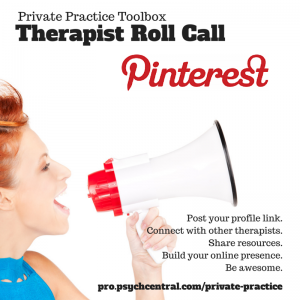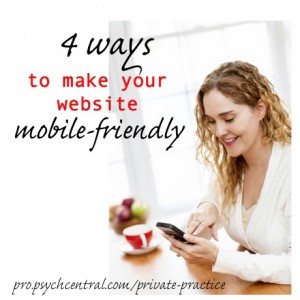 Discover how some very successful mental health professionals use blogging, social media, and other technologies as powerful tools for their therapy practices.
Discover how some very successful mental health professionals use blogging, social media, and other technologies as powerful tools for their therapy practices.
Lisa Mitchell MFT, ATR, LPC, is director of The Art Therapy Studio in Sacramento, CA and owner of InnerCanvas.com. She helps teens and adults use their creativity to heal from trauma, depression, and anxiety. Read here about how Lisa's online presence grew her outreach exponentially:
When and how did you first start putting time and effort into maintaining a strong online presence?
I started 13 months ago with my blog at InnerCanvas.com. I do have a small website for my local private practice, and I wrote an online newsletter for 5 years, but my serious efforts are with my blog.
I first had to commit to the writing schedule. Weekly content is not easy to come up with, and I had to really give myself space to create. I got support from a business coach who helped me know how to engage the readers I did have and how to interest new readers.
As an artist, I love to make things. So, I’ve used this love as a way to create things I know my blog readers and potential blog readers would love to receive as gifts. I’ve created a music playlist, several videos, art invitations, and a quiz. These were fun for the recipients and for me as well. Each time I offer something like this, my email list numbers jump considerably.
While other platforms have been important to growing my audience, I think of my blog as the thing that everything else pivots around. It has become a community that I love and am proud of.
Please describe what social platforms you currently use.
Facebook has been a wonderful place to meet colleagues and make connections. I use it to post blog entries and also get ideas from like-minded therapists.
LinkedIn has been incredible for connections that I couldn’t make on Facebook. I’ve messaged professionals in our field with questions, comments, and gratitude for their work and have engaged in some valuable conversations. The therapist groups on LinkedIn are very active, and I find that I can engage in some really good dialogue around my blog posts and others’ blog posts there.
I’m also on Twitter and Pinterest, but putting energy into these spreads me really thin. I’m thinking of hiring a social media person to cover this for me, but haven’t gone that far yet.
About how much time do you devote to your online presence? How do you balance it with your other work responsibilities?
I have to be really careful about the time I spend online. It is really seductive because I love learning and reading other people’s perspectives so much, so it would be easy to get carried away. I devote about 4 hours a week to blogging, posting, and generally updating my online presence.
I tend to integrate my art and creativity with my online presence, so it doesn’t feel so separate from my other work responsibilities. If I come up with a cool new art invitation, I will share it. If I am experimenting with a new art technique or medium, I’ll share that as well.
I do have a new rule for myself regarding how I use my time in between sessions. I decided that I couldn’t engage in my online activities during the 10 minutes between clients. Instead, I keep my creative process going by making art and/or staying present with real, non-digital activities. I wrote a blog post about it called "Five Ways to Limber Your Thinking Between Sessions" and got some really great responses from my tribe there.
What kinds of things do you use to inspire your content creation; what do you write about?
My focus in writing is to explore the parallels between the creative process and the therapeutic process. The two are beautifully linked, actually one in the same, and I love to think up new ways to teach and inspire therapists about creativity.
I am deeply reflective about my experience as a therapist, and I like to share these reflections in my writing. So my inspiration comes from my work as a therapist and my daily practice as an artist. I have a little list of criteria that I use when I write. I ask myself, Is the piece moving or inspiring? Does it share something meaningful or thought provoking? Is it ethically sound? These questions ensure that my content is not just a journal, but comes full circle and actually makes a point or teaches something.
How do you best balance personal and professional in your online activities? Please give examples.
Because I want to invite therapists to value their work and see it as a creative art form, I do include quite a bit of my own self-reflection in my online activities. I’m very cautious that I don’t violate client confidentiality in the process. Many of my blog posts are pieces that are about real experiences with clients, but I’ve changed much of the information and context in order to adhere to ethics.
I wrote “Sometimes there’s too much sadness....” and “The Art of Permission: What an artist can teach us about therapeutic use of self” in response to my own experiences. In each post, I share some personal thoughts, and then I link these thoughts to a broader, creative view that can apply to being a therapist in general.
What is some tangible evidence that your online presence has grown your business?
My online presence has been invaluable to the growth and expansion of my business. Not only have I met people from all over the world, I’ve also been approached and hired by multiple organizations. My training revenue has increased this year by 175%. My online course for therapists, Artfix, has filled every time I’ve offered it by therapists all over the world!
I’ve also been commissioned to write a book, “Creativity as Co-Therapist: The Practitioner’s Guide to the Art of Psychotherapy." It’s my dream to write this kind of book, and the editor found me first as a faculty member of the Psychotherapy Networker Symposium, read my blog all the way through, and emailed me asking, “Do you have an idea for a book? We’d love to publish it.” The book will be out in the Spring of 2016.
Besides attracting clients, what other ways has your strong online presence helped you?
I was asked to develop a seminar for Cross Country Education as a result of the trainings that I had advertised on my website. Now I travel across the country offering these seminars to professionals who want to learn to use art in therapy safely and effectively.
This might sound silly, but it’s powerful: After my last speaking tour, I had a nightmare of a time flying home from the East Coast. I missed 4 flights, and it ended up taking 29 hours to travel across the county. I decided to post my frustration and sadness on Facebook. The support and well wishes I got from folks who had participated in workshops and follow my blog was touching. I really felt as if the community was there for me when I needed a pick-me-up.
What have been some of the biggest challenges you’ve encountered creating and maintaining your online presence?
The learning curve for me was overwhelming. Four years ago, I had no idea what an autoresponder or an opt-in box was. I am not someone who loves to figure details out, especially on a screen. Because I didn’t have the financial means to hire someone right away, I had to learn. So I took it very slow and gave myself a whole lot of room to experiment and make mistakes. I used to tell myself that I was just slower than everyone else, but I knew I could do it.
I also had to beef up my business marketing skills. My mentor Lynn Grodzki was very helpful and encouraging. I've learned a lot from Casey Truffo about how to earn a significant living through being a therapist. And I’m now part of an ongoing business coaching group with Andrea J. Lee. I learned that I couldn’t scrimp on coaching support. So rather than pay for the technical part to get done for me, I invested heavily in business strategy coaching. It’s really paid off.
What tips or resources can you recommend to help therapists who are new to the online world of blogging, social media, SEO, etc.?
Be kind to yourself and go at your own speed. Don’t invest big dollars until you are somewhat knowledgeable about being online. First, sign up for as many free and low cost opportunities as possible, just to get a feel for what this online world is all about.
We therapists are seldom in the limelight and are used to not being very visible. Check in with your feelings about this. If it feels very scary to show up and be seen by complete strangers, do some work and identify a reason why you want to get online. If you can find a way to turn the fear into excitement, you will do great. If you have a powerful WHY, you will do even better.
 Lisa Mitchell, MFT, ATR, LPC
Licensed Family & Marriage Therapist, Registered Art Therapist
Facebook Page: www.facebook.com/InnerCanvas
Blog: www.innercanvas.com
Website: thearttherapystudio.com
Lisa Mitchell, MFT, ATR, LPC
Licensed Family & Marriage Therapist, Registered Art Therapist
Facebook Page: www.facebook.com/InnerCanvas
Blog: www.innercanvas.com
Website: thearttherapystudio.com
Get practice tips and blog updates in your inbox. Sign up for the Private Practice Toolbox Newsletter here.
Join my Private Practice Toolbox Facebook group and connect with nearly 2000 therapists around the globe in 2 simple steps: 1) Click request to join the group & 2) Fill out this brief questionnaire before you'll be added to the group.
Need help blogging? Join my ongoing therapist blog challenge!
 We've spent thousands and thousands of dollars on graduate education, continuing education, advanced clinical trainings and years in practicum and under supervision. We have invested a lot in our credentials, and all of the impressive acronyms behind our names. PhD, LCSW, LMFT, RPT, CSAC, LPC -- and the list goes on.
We've spent thousands and thousands of dollars on graduate education, continuing education, advanced clinical trainings and years in practicum and under supervision. We have invested a lot in our credentials, and all of the impressive acronyms behind our names. PhD, LCSW, LMFT, RPT, CSAC, LPC -- and the list goes on.






As healers, we genuinely like to do our work. Guiding clients through the therapy process and seeing them make progress is why we do what we do. But if you're in private practice, you know there's a lot going on in the back end and that it's crucial to run an efficient and organized business.